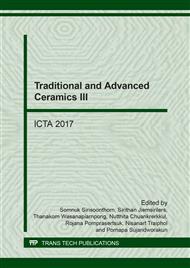p.197
p.205
p.211
p.217
p.223
p.228
p.233
p.241
p.246
The Optimal Ratio of Mixed Talc Silica and Narathiwat Clay for Cordierite-Mullite Refractories
Abstract:
In this paper, effects of incorporation of Narathiwat clay (NT), talc and silica on the mechanical properties of cordierite-mullite refractories were investigated. The starting raw materials were mixed in different ratios and fired at 1300 °C for 2 hours. XRD patterns of fired refectories indicated cordierite and mullite phases. The fired samples were studied the firing shrinkage, water absorption, bulk density, apparent porosity and bending strength of the cordierite-mullite refractories. The optimum condition was achieved for the composition of 20% Talc that had shrinkage: 11.78%, water absorption: 4.16%, bulk density: 2.28 g/cm3, apparent porosity: 9.2% and bending strength: 330.82 kg/cm2. The results thus showed that Narathiwat clay, talc and silica was a potential materials for use kiln furniture cordierite-mullite refractories.
Info:
Periodical:
Pages:
223-227
Citation:
Online since:
April 2018
Authors:
Keywords:
Price:
Сopyright:
© 2018 Trans Tech Publications Ltd. All Rights Reserved
Share:
Citation:


